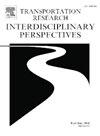Impacts of traffic barrier types on crash severity
IF 3.9
Q2 TRANSPORTATION
Transportation Research Interdisciplinary Perspectives
Pub Date : 2025-07-01
DOI:10.1016/j.trip.2025.101517
引用次数: 0
Abstract
Traffic barriers are known as one of the most popular safety countermeasures to minimize severe collisions from crossing medians and run-off-road at locations with non-traversable roadsides. This paper examines the impact of different traffic barrier types on crash severity with five years (2016–2020) crash data from Iowa using a causal inference framework. This includes genetic matching to reduce selection bias and the use of random parameters ordinal logistic regression to estimate the impacts of the barrier types on crash severity. Barriers were classified into three groups for the analysis: guardrails (i.e., semi-rigid), cable barriers (i.e., flexible) and concrete barriers (i.e., rigid). In order to make comparisons across barrier types, genetic matching was performed for paired comparisons (e.g., concrete vs. cable barrier) and then marginal effects were estimated to determine the differences in crash severity. According to the results, the cable barrier is associated with the lowest injury while the concrete barrier is associated with the highest injury levels. Guardrails are safer than concrete barriers and less safe than cable barriers. It is also found that if concrete barrier or guardrail is involved in the crash, there is 12.09 % and 7.69 % increased probability of an injury compared to cable barriers, respectively.
交通障碍类型对碰撞严重程度的影响
交通障碍被认为是最受欢迎的安全对策之一,以最大限度地减少十字路口中间的严重碰撞和在不可穿越的路边奔跑的地方。本文使用因果推理框架,利用爱荷华州5年(2016-2020年)碰撞数据,研究了不同交通障碍类型对碰撞严重程度的影响。这包括遗传匹配以减少选择偏差和使用随机参数有序逻辑回归来估计障碍类型对碰撞严重程度的影响。屏障被分为三组进行分析:护栏(即半刚性),电缆屏障(即柔性)和混凝土屏障(即刚性)。为了进行跨屏障类型的比较,对配对比较(例如,混凝土屏障与电缆屏障)进行基因匹配,然后估计边际效应以确定碰撞严重程度的差异。结果表明,电缆屏障的损伤程度最低,混凝土屏障的损伤程度最高。护栏比混凝土护栏更安全,比电缆护栏更不安全。研究还发现,如果混凝土屏障或护栏参与碰撞,与电缆屏障相比,受伤的可能性分别增加12.09%和7.69%。
本文章由计算机程序翻译,如有差异,请以英文原文为准。
求助全文
约1分钟内获得全文
求助全文
来源期刊

Transportation Research Interdisciplinary Perspectives
Engineering-Automotive Engineering
CiteScore
12.90
自引率
0.00%
发文量
185
审稿时长
22 weeks
 求助内容:
求助内容: 应助结果提醒方式:
应助结果提醒方式:


